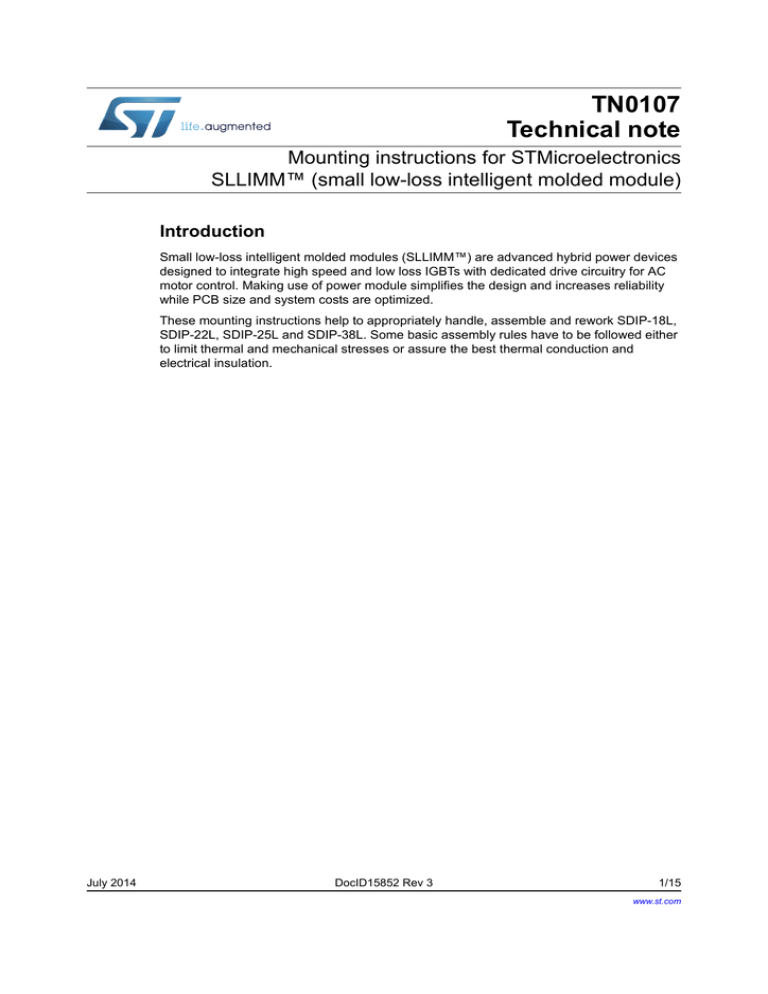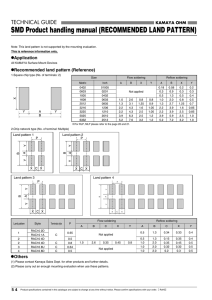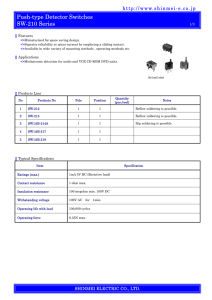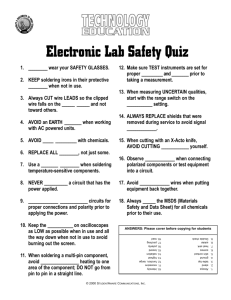
TN0107
Technical note
Mounting instructions for STMicroelectronics
SLLIMM™ (small low-loss intelligent molded module)
Introduction
Small low-loss intelligent molded modules (SLLIMM™) are advanced hybrid power devices
designed to integrate high speed and low loss IGBTs with dedicated drive circuitry for AC
motor control. Making use of power module simplifies the design and increases reliability
while PCB size and system costs are optimized.
These mounting instructions help to appropriately handle, assemble and rework SDIP-18L,
SDIP-22L, SDIP-25L and SDIP-38L. Some basic assembly rules have to be followed either
to limit thermal and mechanical stresses or assure the best thermal conduction and
electrical insulation.
July 2014
DocID15852 Rev 3
1/15
www.st.com
Contents
TN0107
Contents
1
2
3
4
5
2/15
Installation guide: heatsink mounting . . . . . . . . . . . . . . . . . . . . . . . . . . . 3
1.1
Silicon grease . . . . . . . . . . . . . . . . . . . . . . . . . . . . . . . . . . . . . . . . . . . . . . . 3
1.2
Mounting torque . . . . . . . . . . . . . . . . . . . . . . . . . . . . . . . . . . . . . . . . . . . . . 4
1.3
Screw tightening torque . . . . . . . . . . . . . . . . . . . . . . . . . . . . . . . . . . . . . . . 4
1.4
Recommended screws . . . . . . . . . . . . . . . . . . . . . . . . . . . . . . . . . . . . . . . . 6
Handling precautions and storage notices . . . . . . . . . . . . . . . . . . . . . . . 7
2.1
Transportation . . . . . . . . . . . . . . . . . . . . . . . . . . . . . . . . . . . . . . . . . . . . . . 7
2.2
Storage . . . . . . . . . . . . . . . . . . . . . . . . . . . . . . . . . . . . . . . . . . . . . . . . . . . . 7
2.3
Environment . . . . . . . . . . . . . . . . . . . . . . . . . . . . . . . . . . . . . . . . . . . . . . . . 7
2.4
Electrical shock . . . . . . . . . . . . . . . . . . . . . . . . . . . . . . . . . . . . . . . . . . . . . 8
Reflow . . . . . . . . . . . . . . . . . . . . . . . . . . . . . . . . . . . . . . . . . . . . . . . . . . . . . 9
3.1
Selective wave soldering of SLLIMM . . . . . . . . . . . . . . . . . . . . . . . . . . . . . 9
3.2
Other soldering techniques . . . . . . . . . . . . . . . . . . . . . . . . . . . . . . . . . . . 10
3.3
Pin-in-paste . . . . . . . . . . . . . . . . . . . . . . . . . . . . . . . . . . . . . . . . . . . . . . . .11
3.4
Heatsink mounting by reflow soldering . . . . . . . . . . . . . . . . . . . . . . . . . . . .11
Rework . . . . . . . . . . . . . . . . . . . . . . . . . . . . . . . . . . . . . . . . . . . . . . . . . . . 12
4.1
Device removal . . . . . . . . . . . . . . . . . . . . . . . . . . . . . . . . . . . . . . . . . . . . . 12
4.2
Site redressing . . . . . . . . . . . . . . . . . . . . . . . . . . . . . . . . . . . . . . . . . . . . . 12
4.3
Reassembly and reflow . . . . . . . . . . . . . . . . . . . . . . . . . . . . . . . . . . . . . . 13
4.4
Coating of assembled PCBs . . . . . . . . . . . . . . . . . . . . . . . . . . . . . . . . . . 13
Revision history . . . . . . . . . . . . . . . . . . . . . . . . . . . . . . . . . . . . . . . . . . . 14
DocID15852 Rev 3
TN0107
1
Installation guide: heatsink mounting
Installation guide: heatsink mounting
Here below basic guidelines to assure safe heatsink mounting:
1.1
•
Avoid applying excessive pressure to the SLLIMM, as it could damage the module and
cause saturation of thermal dissipation capability.
•
Smooth the surface by removing burrs and protrusions of indentations to assure good
contact between the SLLIMM and the heatsink.
•
Do not touch the heatsink when the application runs to avoid burn injury.
Silicon grease
The silicon grease has to be applied between SDIP module and the heatsink to reduce the
contact thermal resistance. High quality grease with stable performance should be used
within the operating temperature range of the power module. The coating has to be applied
thinly and evenly, taking care not to leave any voids on the contact surface between the
module and the heatsink. A uniform layer of silicon grease (from 100 µm up to 200 µm of
thickness, see Figure 1) should be also applied to prevent corrosion.
Figure 1. Recommended silicon grease thickness
SDIP-IPM
Silicon grease
100~200 µm thickness
Heat sink
DocID15852 Rev 3
AM01284v1
3/15
15
Installation guide: heatsink mounting
1.2
TN0107
Mounting torque
Fastening torque specifications are provided in Table 1.
Table 1. Mounting torque and heatsink flatness specifications
Item
Conditions
Mounting torque
Mounting
screw:M3
Min.
Typ. Max.
Unit
Recommended 7 kgf· cm
4
7
10
kgf.cm
Recommended 0.7 N· m
0.4
0.7
1
N· m
Device flatness
See Figure 2
0
150
µm
Heatsink flatness
See Figure 2
-50
150
µm
The device and heatsink flatness are indicated in Figure 2.
Figure 2. Device and heatsink flatness specifications
&XKHDWVLQNVXUIDFH
7RSYLHZ
1.3
$0Y
Screw tightening torque
Do not exceed the specified fastening torque. Overtightening screws may cause ceramic or
molding compound crack, as shown in Figure 3. Tightening screws beyond a certain torque
can cause saturation of the contact thermal resistance.
4/15
DocID15852 Rev 3
TN0107
Installation guide: heatsink mounting
Figure 3. Overtightening causes molding compound crack
Molding compound crack
GIPG1406031450SA
Figure 4 shows the recommended fastening sequence to mount screws. ST recommends
setting torque at 0.2/0.3N· m for temporary tight mounting screws, while for permanently
tight mounting screws, the suggested torque is 0.7 N· m (1 N· m max.) crosswise.
To reduce fastening process cycle time, two-steps permanently tightening is also possible:
If two-steps permanent tightening is applied, thermal grease may not evenly distribute
between the module and the external heatsink. In case of use of electrical or pneumatic
screwdriver, a revolution at 200 rpm max. is suggested, because a quick impact of screw
may damage the module plastic body.
Figure 4. Mounting screws: recommended fastening order
GIPG1406031528SA
DocID15852 Rev 3
5/15
15
Installation guide: heatsink mounting
1.4
TN0107
Recommended screws
All mounting screws should have washers and spring washer to get the best results. SEMS
screw is recommended (included spring/plain washer M3) as shown in Figure 5.
Figure 5. SEMS screw (size M3, spring washer 5.0 Φ, plain washer 7.5 Φ)
GIPG1406031544SA
6/15
DocID15852 Rev 3
TN0107
2
Handling precautions and storage notices
Handling precautions and storage notices
Thermal and/or mechanical stress may deteriorate the device’s electrical characteristics
and/or its reliability.
2.1
Transportation
The device and its packaging material have to be handled with care. The device shouldn’t
be subjected to mechanical vibration or shock during transport. Wet conditions are
dangerous as well as moisture can also adversely affect the packaging. The devices should
be placed in the conductive trays before using them. Leads shouldn’t be touched. Package
boxes have not to be stressed because stress might cause the electrode terminals to be
deformed or the resin case to be damaged. Throwing or dropping the packaging boxes
might cause the devices to be damaged. Wetting packaging boxes might cause the
breakdown of the devices.
2.2
2.3
Storage
•
The storage area cannot be exposed to moisture or direct sunlight.
•
Humidity should be kept within the range from 40% to 75%, and the temperature also
shouldn’t be over 35 °C or below 5 °C.
•
Harmful gases or dusty environments are dangerous.
•
Lead solderability can be degraded by lead oxidation or corrosion, therefore the
minimal temperature fluctuation is highly recommended.
•
Antistatic containers are recommended. Unused devices should be stored no longer
than one month.
Environment
•
The board container or bag protects against static discharge. Boards shouldn’t be
stacked directly on top of one another and they have to be separated from each other
to avoid static charge/discharge caused by friction.
•
Cart surface material, in contact with the device packaging, conducts static electricity,
and is grounded to the floor surface with a grounding chain.
•
Finger cots or gloves have to be worn to protect the device against static electricity.
•
When humidity in the working environment decreases, the human body and other
insulators can easily become charged with electrostatic electricity due to friction
Therefore the recommended humidity is within 40%, 60% in the work environment. Be
aware of the risk of moisture absorption by the products after unpacking from moistureproof packaging.
•
Equipment and tools in the working area have to be grounded to earth.
•
Appropriate measures (place a conductive mat over the floor of the work area) have to
be taken so that the floor surface is grounded to earth and is protected against
electrostatic electricity.
•
The workbench surface has to be covered with a conductive mat, grounded to earth, to
disperse electrostatic electricity on the surface through resistive components
DocID15852 Rev 3
7/15
15
Handling precautions and storage notices
TN0107
Workbench surfaces must not be built of low-resistance metallic material that allows
rapid static discharge when a charged device touches it directly.
2.4
•
Work chairs have to be protected with an antistatic textile cover and grounded to the
floor surface with a grounding chain.
•
Antistatic mats have to be installed on storage shelf surfaces.
•
For transport and temporary storage of devices, containers have to be made of
antistatic materials dissipating static electricity.
•
Operators must wear antistatic clothing and conductive shoes (or a leg or heel strap).
•
Operators must wear a wrist strap grounded to earth through a resistor of about 1 Ω.
•
If the tweezers used touch the device terminals, an antistatic type should be used and
metallic tweezers should be avoided. If a charged device touches a low-resistance tool,
a rapid discharge can occur. When vacuum tweezers are used, a conductive chucking
pad should be attached to the tip and connected to a dedicated ground used for
antistatic purposes.
Electrical shock
The device has not to be touched unless the power to the measuring instrument is off. This
is to avoid the device’s electrical shock.
8/15
DocID15852 Rev 3
TN0107
3
Reflow
Reflow
The SLLIMM is intended to be a through hole device (THD). THDs are typically soldered by
wave soldering. However, as the number of THDs on a board continues decreasing in some
applications, wave soldering becomes less cost-effective, so the few remaining THDs
(mostly connectors and special components) are soldered with selective wave soldering or
with pin-in-paste techniques plus reflow soldering.
3.1
Selective wave soldering of SLLIMM
Wave soldering is a large-scale soldering process by which electronic components are
soldered to a PCB to form an electronic assembly. The name derives from the fact that the
process uses a tank to hold a quantity of molten solder; components are inserted into or
placed on the PCB and the loaded PCB is passed across a pumped wave or cascade of
solder. The solder wets the exposed metallic areas of the board (those not protected with
solder mask), creating a reliable mechanical and electrical connection.
For THDs, only the leads that extend through the drill holes in the PCB contact the hot
solder. The body of the package is heated by the hot leads. This has two consequences:
1.
The package body is cooler than in the case of reflow soldering.
2.
The temperature gradient between leads and body and inside the package is greater
than in the case of reflow soldering.
Therefore, for wave-solderable THDs, the heat resistance is tested according to JESD22B106 and IEC668 2-20 (typically 260 °C, 10 s).
Note:
Immersion of the whole package body into the molten solder is not recommended since the
SLLIMM is not designated for such a harsh temperature shock.
For evaluation of its ability to withstand full body immersion please see JESD22-A111.
There are many types of wave-soldering machines, but their basic components and
principles are the same. A standard wave-soldering machine consists of three zones: the
fluxing zone, the preheating zone, and the soldering zone. A fourth zone, the cleaning zone,
may be used depending on the type of flux applied.
Dual-wave soldering is the most commonly used wave-soldering method (please see
Figure 6). The peak temperatures, ramp rates, and times that are used depend on the
materials and the wave-soldering equipment.
The first wave has a turbulent flow and therefore guarantees a wetting of nearly all shapes
of leads and board pads, but also creates an increased number of unwanted solder bridges.
These solder bridges have to be removed by the second, laminar wave.
When using lead-free solder alloys, a nitrogen atmosphere is recommended.
Selective wave soldering is used when only a few THDs have to be soldered onto the board.
Generally this is done after the other components are already soldered by reflow soldering.
This requires effective protection of these components undergoing the selective wave
soldering. This protection can be achieved either by using special fixtures and deflectors for
the PCB or a small wave shape achieved by using special wave-guiding tubes or covers.
DocID15852 Rev 3
9/15
15
Reflow
TN0107
Figure 6. Typical dual-wave soldering profile
GIPG1406031638SA
3.2
Other soldering techniques
Beside wave and reflow soldering, other techniques are used in special applications.
Examples include selective wave soldering, laser welding and laser soldering, hot bar
soldering, and manual soldering with solder irons and hot air guns.
For this broad group of soldering techniques, which cannot be tested for every component,
some general guidelines should be followed:
•
The maximum temperature of the package body and leads must not exceed the
maximum allowed temperature for reflow or wave soldering.
•
The maximum allowed time at high temperatures must not exceed the maximum
allowed time for reflow or wave soldering.
•
If heat is applied to the leads, the maximum temperatures in the package and of the
package body must not exceed the maximum allowed temperatures during reflow or
wave soldering.
•
For details and special arrangements, please refer to the product datasheet and/or
qualification report.
If long contact and heating times are unavoidable, the resulting temperatures on different
leads near the package body should be measured and compared to the temperatures and
duration achieved during wave or reflow soldering, which must not be exceeded.
Please ask your local sales, quality, or application engineer to provide you with the
evaluation report for further information if needed.
10/15
DocID15852 Rev 3
TN0107
3.3
Reflow
Pin-in-paste
Another technique used to solder THDs is to print solder paste onto a PCB near or over drill
holes through which the leads are then inserted. The reflow of the solder paste is done
together with soldering the SMDs, which therefore have to go through the reflow
temperature profile. This has two consequences:
1.
The temperature is nearly the same for the whole package in contrast to wave
soldering.
2.
The time for which the peak temperature is applied to the package is much longer
compared to wave soldering.
THDs are qualified for wave soldering and not for reflow soldering. Therefore, pin-in-paste
soldering techniques are not recommended for the SLLIMM.
3.4
Heatsink mounting by reflow soldering
In special applications the heatsinks of high-power THDs can be mounted to the board by
solder paste printing, pick-and-place, and reflow soldering. In this case, the packages
undergo a reflow profile. THDs are qualified for wave soldering and not for the reflow
soldering. Therefore, reflow soldering should not be used for the heatsink mounting for the
SLLIMM.
DocID15852 Rev 3
11/15
15
Rework
4
TN0107
Rework
If a defective component is observed after the board assembly, the device can be removed
and replaced by a new one. Repair of single solder joints is generally possible, but requires
proper tools. For example, repairing the solder joint of an exposed die pad cannot be done
by a soldering iron.
Whatever rework process is applied, it is important to recognize that heating a board and
components above 200 °C may result in damage. As a precaution, every board with its
components has to be baked prior to rework. For details, please refer to the international
standard J-STD-033.
In any case, mechanical, thermal or thermo-mechanical overstress has to be avoided, and
rework has to be done according to JEDEC J-STD-033A, IPC-7711 and IPC-7721.
4.1
Device removal
If a defective component is sent back to the supplier, no further defects must be caused
during the removal of this component, because this may hinder the failure analysis by the
supplier. The following recommendations should be considered:
4.2
•
Moisture: depending on the MSL, the package may have to be dried before removal. If
the maximum storage time out of the dry pack (see label on packing material) is
exceeded after board assembly, the PCB has to be baked according to the
recommendations of the PCB manufacturer. Otherwise, too much moisture may have
been accumulated and damage may occur (“popcorn” effect).
•
Temperature profile: during the desoldering process it should be assured that the
package peak temperature is not higher and temperature ramps are not steeper than
for the standard assembly wave process.
•
Mechanics: be careful not to apply high mechanical forces for removal. Otherwise
failure analysis of the package can be impossible, or PCB can be damaged. For large
packages, pipettes can be used (implemented on most rework systems); for small
packages, tweezers may be more practical.
Site redressing
After removing the defective component, pads on the PCB have to be cleaned to remove
solder residues. This may be done by vacuum desoldering or wick.
Don’t use steel brushes because steel residues can lead to bad solder joints. Before placing
a new component, it may be necessary to apply solder paste on PCB pads by printing
(special micro-stencil) or dispensing.
12/15
DocID15852 Rev 3
TN0107
4.3
Rework
Reassembly and reflow
After preparing the site, the new package can be placed onto the PCB and the leads are to
be inserted into the holes. Regarding placement accuracy and placement force, the process
should be comparable to the (automatic) pick-and-place process.
During the soldering process, it should be assured that the package peak temperature is not
higher and temperature ramps are not steeper than for the standard assembly process.
Soldering wire can be used to re-solder the leads. Use no-clean solder paste only, solder
wire, and flux for repair.
4.4
Coating of assembled PCBs
In some applications, coatings are used to prevent damage due to external influences such
as:
Mechanical abrasion
Vibration
Shock
Humidity
Hand perspiration
Chemicals and corrosive gases
These influences may cause:
•
Electrical leakage due to humidity.
•
Corrosion that leads to degradation of conductor paths, solder joints, and any other
metalized areas, and/or formation of electrical leakage paths. These can eventually
result in electrical shorts (electrical leakage) or open contacts.
•
Mechanical damage to conductor paths, solder joints, and components. This damage
can lead to electrical failures.
Coatings act as electrically isolating and impervious covers that adhere well to the different
PCB materials.
A wide variety of different coatings is available on the market. They differ in:
Price
Simple processability (spray, dip, casting, curing, etc.)
Reparability
Controllability
Homogeneity
In any case, please be aware of the chemical, electrical, mechanical and thermomechanical interaction between the coating and the PCB and its components. Coatings can
affect component reliability.
DocID15852 Rev 3
13/15
15
Revision history
5
TN0107
Revision history
Table 2. Document revision history
14/15
Date
Revision
Changes
07-Mar-2010
1
Initial release.
13-Jul-2011
2
Modified: heatsink flatness max. value Table 1
21-Jul-2014
3
The entire technical content has been modified.
DocID15852 Rev 3
TN0107
IMPORTANT NOTICE – PLEASE READ CAREFULLY
STMicroelectronics NV and its subsidiaries (“ST”) reserve the right to make changes, corrections, enhancements, modifications, and
improvements to ST products and/or to this document at any time without notice. Purchasers should obtain the latest relevant information on
ST products before placing orders. ST products are sold pursuant to ST’s terms and conditions of sale in place at the time of order
acknowledgement.
Purchasers are solely responsible for the choice, selection, and use of ST products and ST assumes no liability for application assistance or
the design of Purchasers’ products.
No license, express or implied, to any intellectual property right is granted by ST herein.
Resale of ST products with provisions different from the information set forth herein shall void any warranty granted by ST for such product.
ST and the ST logo are trademarks of ST. All other product or service names are the property of their respective owners.
Information in this document supersedes and replaces information previously supplied in any prior versions of this document.
© 2014 STMicroelectronics – All rights reserved
DocID15852 Rev 3
15/15
15




